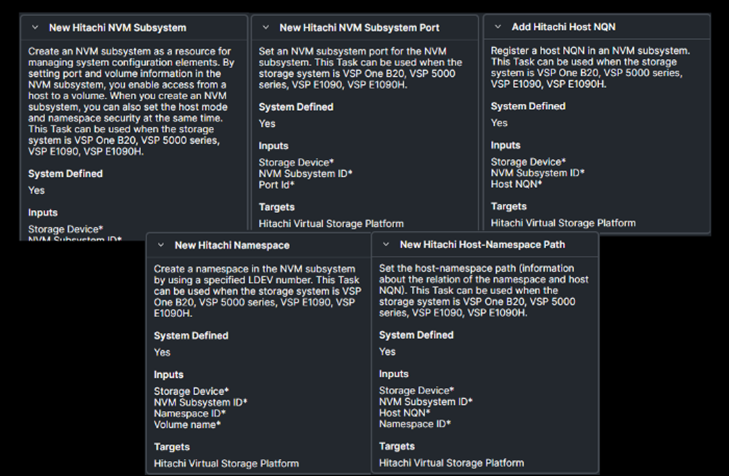In today’s enterprise and cloud infrastructures, achieving high throughput, low latency, and efficient scale-out is increasingly critical. Storage bottlenecks are often the culprit—especially in virtualization, AI/ML, analytics, and database workloads where I/O demands are intense.
Traditional SANs (Fibre Channel or iSCSI) have served well, but newer protocols such as NVMe over Fabrics (NVMe-oF) promise lower latency, improved parallelism, and better use of NVMe SSDs/disaggregated storage. Among NVMe-oF transports, NVMe/TCP provides an attractive trade-off: leveraging existing TCP/IP networks rather than requiring specialized fabrics such as RDMA (RoCE).
The Adaptive Solutions with Cisco UCS X215c M8 and Hitachi VSP One Block E2E 100G VMware (CVD) is a validated architecture that demonstrates how to build a converged infrastructure combining Cisco UCS compute + Nexus networking + Hitachi Virtual Storage Platform One (VSP One) Block storage, using NVMe/TCP as the transport mechanism. It provides guidance, best practices, and insights to help customers deploy NVMe-oF in real-world environments.

Rather than forcing an all-or-nothing transition, organizations can adopt NVMe/TCP where needed with this design (for example, for latency-sensitive apps that require higher throughput when compared to iSCSI) while continuing to support legacy workloads using hybrid approaches. This flexibility makes it attractive for organizations in transition as well as customers that require:
- High-performance virtualized workloads (databases, analytics, AI/ML) that demand low-latency and high IOPS.
- Greenfield deployments or data center refreshes where you want to adopt NVMe-oF and keep OPEX costs low by using only Ethernet switches, avoiding the expenses for additional Fibre Channel switches.
- Workload segmentation, where a subset of machines/applications requires NVMe-tier performance while others stay on traditional SAN.
- Hybrid environments where legacy SAN remains, but newer services need next-gen storage I/O.
- Running NVMe/TCP over standard Ethernet to reduce deployment complexity.
- Coexistence with Fibre Channel - allowing a gradual migration rather than big-bang leaps also giving breathing room for transition.
Within this architecture, “100G end-to-end” means that every link in the data path — from the server VICs, through the fabric interconnects, switches, and all the way to the storage controllers — runs at 100 Gbps, with no mixed-speed uplinks while every hop supports full-bandwidth, low-latency data movement. This end-to-end full bandwidth capability paired with NVMe SSDs and an optimized command set that reduces storage protocol overhead results in a data path capable of near-local-NVMe performance across a shared Ethernet network.

Another value of Hitachi VSP within this architecture is that it can natively coexist within the Cisco UCS domain management, this is done with Intersight integration by allowing the Hitachi VSP to be positioned into the same operational umbrella as your compute and network infrastructure. Rather than switching between separate consoles or coordinating across siloed teams, you gain unified visibility, unified policy control, and improved automation. Within this CVD, NVMe-oF system configuration can be done using Intersight Cloud Orchestrator. The following native Hitachi tasks have been recently developed to help end users configure NVMe-oF resources:


This is all done while Intersight Inventory Services (IIS) provides native insights into inventory statistics for all deployed logical resources within a Hitachi VSP system which includes NVMe-oF.

This unified management approach is key in modern data centers, while traditional siloed management across compute, network, and storage adds friction, complexity, and risk.
The Adaptive Solutions with Cisco UCS X215c M8 and Hitachi VSP One Block E2E 100G VMware is a compelling blueprint for bridging today’s enterprise SAN world with tomorrow’s NVMe-centric architectures. It provides proven, tested, and documented validation for building reliable IT infrastructure with Hitachi VSP One block in conjunction with NVMe/TCP by combining protocol flexibility, validated performance, unified management, and migration-friendly path. All this makes it a strong contender for modern data centers by offering the “sweet spot” of speed, simplicity, and scalability all while allowing enterprises to modernize storage and compute without introducing the complexity of specialized fabrics.
To view a full list of available Cisco and Hitachi Adaptive Solutions, see the Cisco Design Zone.
Design Guide: https://www.cisco.com/c/en/us/td/docs/unified_computing/ucs/UCS_CVDs/ucs_hitachi_adaptive_solutions_nvme_tcp_design.html
Deployment Guide: https://www.cisco.com/c/en/us/td/docs/unified_computing/ucs/UCS_CVDs/ucs_hitachi_adaptive_solutions_nvme_tcp.html
#Cisco-ValidatedDesign